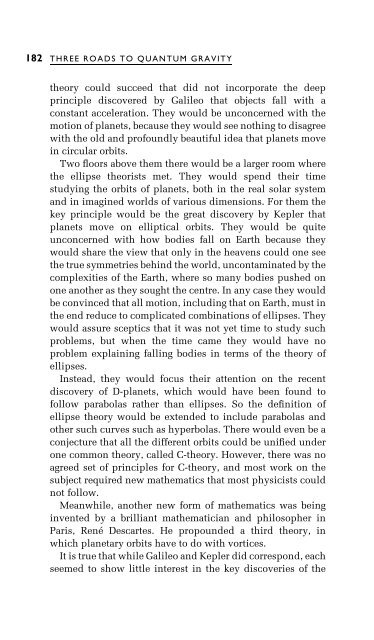Three Roads To Quantum Gravity
Three Roads To Quantum Gravity
Three Roads To Quantum Gravity
You also want an ePaper? Increase the reach of your titles
YUMPU automatically turns print PDFs into web optimized ePapers that Google loves.
182 THREE ROADS TO QUANTUM GRAVITY<br />
theory could succeed that did not incorporate the deep<br />
principle discovered by Galileo that objects fall with a<br />
constant acceleration. They would be unconcerned with the<br />
motion of planets, because they would see nothing to disagree<br />
with the old and profoundly beautiful idea that planets move<br />
in circular orbits.<br />
Two ¯oors above them there would be a larger room where<br />
the ellipse theorists met. They would spend their time<br />
studying the orbits of planets, both in the real solar system<br />
and in imagined worlds of various dimensions. For them the<br />
key principle would be the great discovery by Kepler that<br />
planets move on elliptical orbits. They would be quite<br />
unconcerned with how bodies fall on Earth because they<br />
would share the view that only in the heavens could one see<br />
the true symmetries behind the world, uncontaminated by the<br />
complexities of the Earth, where so many bodies pushed on<br />
one another as they sought the centre. In any case they would<br />
be convinced that all motion, including that on Earth, must in<br />
the end reduce to complicated combinations of ellipses. They<br />
would assure sceptics that it was not yet time to study such<br />
problems, but when the time came they would have no<br />
problem explaining falling bodies in terms of the theory of<br />
ellipses.<br />
Instead, they would focus their attention on the recent<br />
discovery of D-planets, which would have been found to<br />
follow parabolas rather than ellipses. So the de®nition of<br />
ellipse theory would be extended to include parabolas and<br />
other such curves such as hyperbolas. There would even be a<br />
conjecture that all the different orbits could be uni®ed under<br />
one common theory, called C-theory. However, there was no<br />
agreed set of principles for C-theory, and most work on the<br />
subject required new mathematics that most physicists could<br />
not follow.<br />
Meanwhile, another new form of mathematics was being<br />
invented by a brilliant mathematician and philosopher in<br />
Paris, Rene Descartes. He propounded a third theory, in<br />
which planetary orbits have to do with vortices.<br />
It is true that while Galileo and Kepler did correspond, each<br />
seemed to show little interest in the key discoveries of the



![arXiv:1001.0993v1 [hep-ph] 6 Jan 2010](https://img.yumpu.com/51282177/1/190x245/arxiv10010993v1-hep-ph-6-jan-2010.jpg?quality=85)


![arXiv:1008.3907v2 [astro-ph.CO] 1 Nov 2011](https://img.yumpu.com/48909562/1/190x245/arxiv10083907v2-astro-phco-1-nov-2011.jpg?quality=85)








![arXiv:1002.4928v1 [gr-qc] 26 Feb 2010](https://img.yumpu.com/41209516/1/190x245/arxiv10024928v1-gr-qc-26-feb-2010.jpg?quality=85)
![arXiv:1206.2653v1 [astro-ph.CO] 12 Jun 2012](https://img.yumpu.com/39510078/1/190x245/arxiv12062653v1-astro-phco-12-jun-2012.jpg?quality=85)
